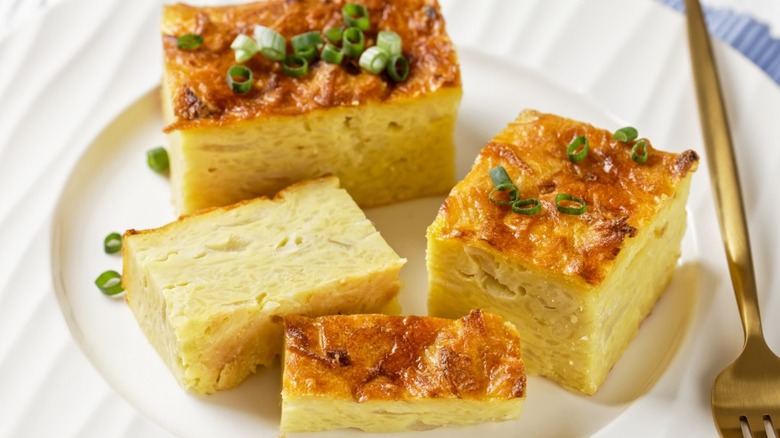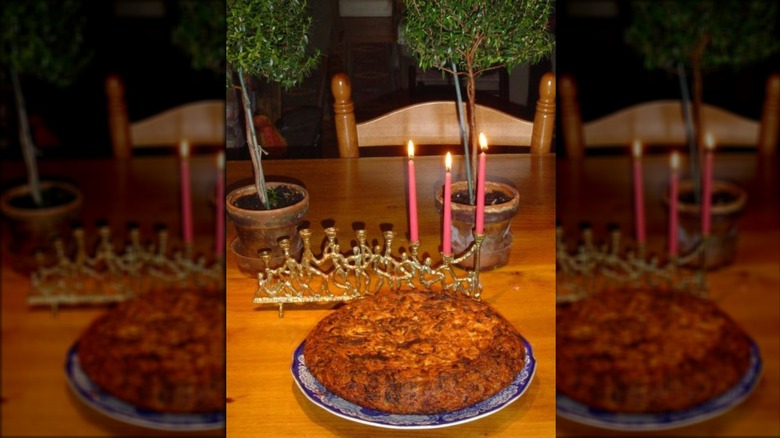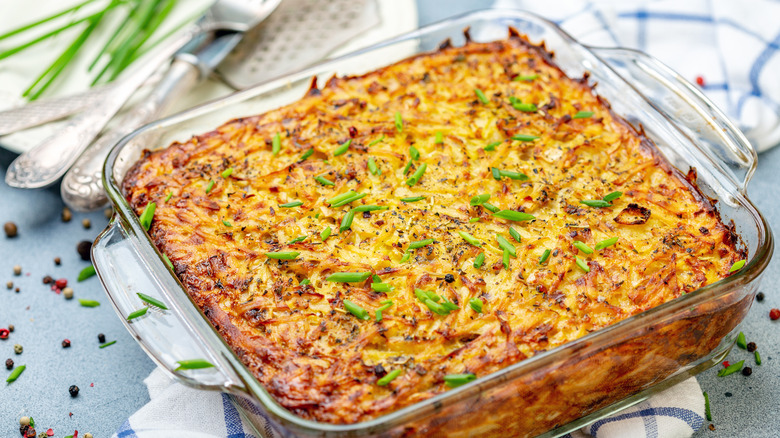The Real Connection Between Kugel And Hanukkah
We may receive a commission on purchases made from links.
If there is any food that is associated with Hanukkah above all others, it is ... not kugel, but latkes. Still, one type of kugel may often appear on Hanukkah tables: kugel made from potatoes. There are actually numerous kinds of kugel, but some of the earliest versions of the dish appear to have been bread-based ones that may have been similar to stuffing or savory bread pudding. 13th-century German cooks seem to have been the first to replace bread with noodles, while later ones added dairy products to transform kugel into the creamy dish we know today.
While noodle kugel may be the best-known type, there are also kugels made with fruit, vegetables (yes, zucchini kugel is a thing), and even a matzo kugel popular at Passover. At a Hanukkah gathering, though, you're most likely to see potato kugel. The reason for this may be that potato kugels, particularly pan-fried ones, could be seen as variants of the traditional latke. If you stick to baking your potato kugel, it's also considerably less labor-intensive than frying up a batch of latkes. While tradition may be the main reason many Jewish households make potato kugel a part of their Hanukkah celebration, kugels also have a certain religious significance, as well, which pertains to Jewish Shabbats.
Early Talmudic scholars made mention of a kugel-type dish
In the scriptures, it's stated that the Jewish Shabbat is to be "a day of delight." From ancient times to the present, delicious food plays a significant role in any delightful occasion, be it Shabbat or High Holy Day. While Hanukkah is not one of those High Holy Days — only Yom Kippur and Rosh Hashanah merit this specific designation — it's meant to be a joyful celebration nonetheless and thus merits its share of delightful goodies.
Why kugel, though? Early Talmudic scholars spoke of a dish called pashtida that was made with two layers of dough surrounding a savory filling. The 14th-century Rabbi Yaakov ben Moshe (Moelin) ha-Levi, who was called the Maharil, said the dish symbolizes the manna that the Bible tells us fell from heaven in order to sustain the Jews while they endured a 40-year desert exile. The crust represents the dew fall that both preceded and followed the shower of manna while the filling represents the manna itself, which was said to taste better on Shabbat. What's more, according to Jewish numerology, the word "pashtida" has the same numeric value as the name of God. Although today's kugels have evolved to the point where they bear little resemblance to the pashtidas of yore, they've inherited their predecessors' symbolic mantle. To eat kugel, for Hanukkah or another celebration, is to participate in a tradition dating back to the early days of Judaism.
Kugel can play a part in your personal Hanukkah tradition
Even though kugel may not be a Hanukkah-specific tradition, recipes for this dish regularly get trotted out around this holiday by major media outlets such as The New York Times and The Washington Post. Both newspapers touted the sweet and savory Yerushalmi kugel as a Hanukkah recipe a few years back and, as the holiday has no particular dietary restrictions attached a la Passover, there's really no reason it, or any other kugel, couldn't become part of your Hanukkah tradition if you wish.
In fact, a sweet children's book called "Kugel for Hanukkah?" seems to be making a case for adopting kugel as a Hanukkah dessert. In the book, author Gretchen M. Everin tells the story of a family who celebrate all eight nights of Hanukkah by eating latkes and giving each other somewhat baffling presents. Well, the odd gifts, at least, go to the grandmother and the little girl who is the main character. On the eighth night, it's revealed that the girl's gifts are supplies she'll need for her new pet, while Bubbeh's bequests — items like cinnamon sticks and vanilla extract — are ingredients for making the girl's favorite cranberry-chocolate kugel. (Nice, but we hope someone also got Granny a gift certificate for a spa day.) If anyone reading this book is inspired by the story, they'll find a recipe at the end that will allow their family to recreate this kugel for their own celebration.


